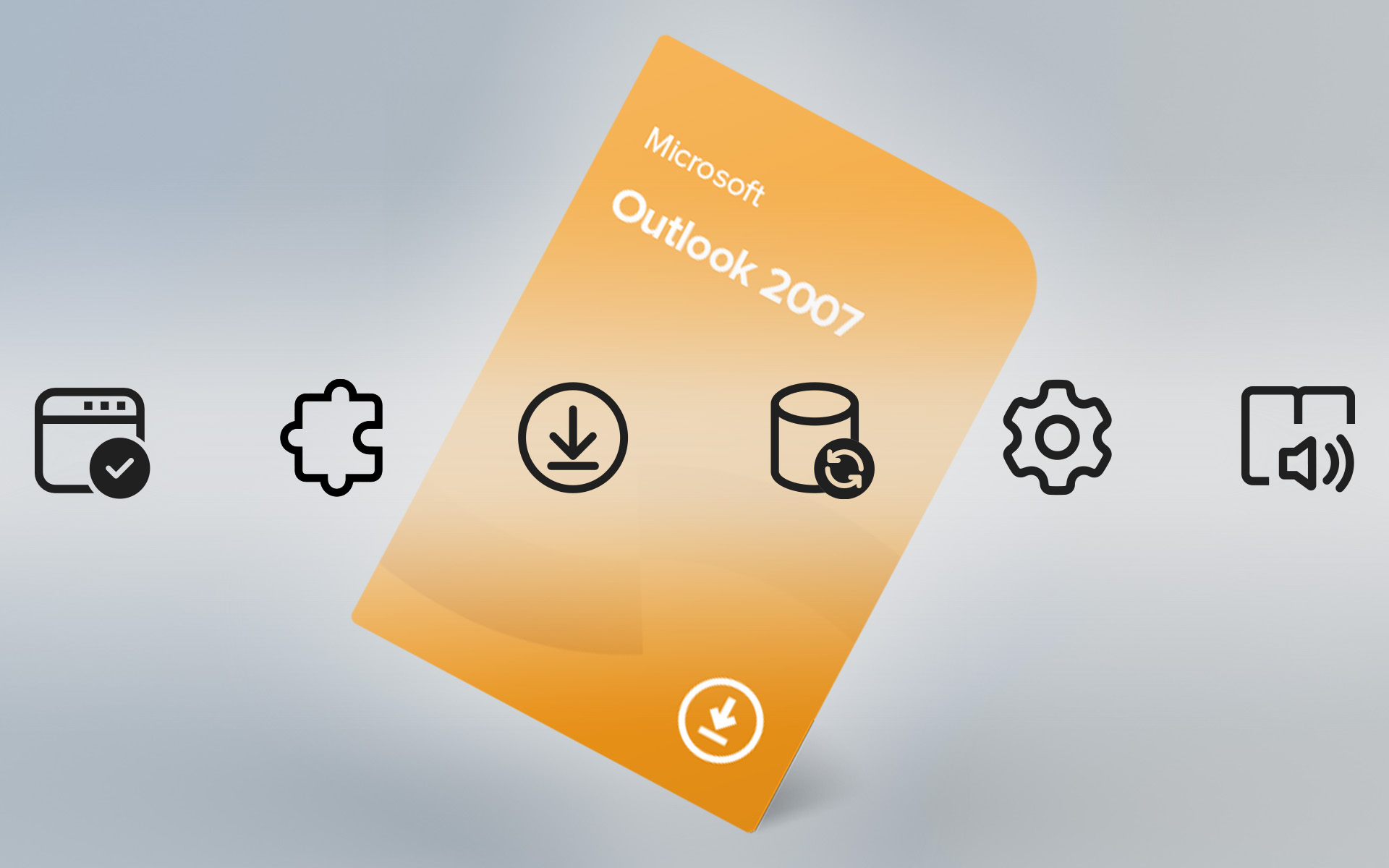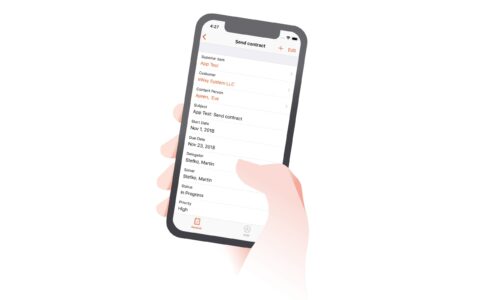While Outlook 2007 has long served as a reliable cornerstone for professionals, the escalating demands of modern business require more.

Imagine enhancing your trusted Outlook with features that streamline customer interactions and centralize data. Integrating a CRM does precisely that, combining the familiar with the sophisticated, and elevating your operational prowess.
Let’s take a look at the steps on how to add a CRM to Outlook 2007 – a solution tailored to today's business dynamics and tomorrow's aspirations.
Table of Contents:
Understanding the Need for CRM Integration in Outlook 2007
Selecting the Right CRM for Integration with Outlook 2007
Steps on How to Add CRM to Outlook 2007
Fine-Tuning for Your Business Needs
The eWay-CRM Advantage with Seamless Outlook Integration
The Power of Integration for Tomorrow's Business
Understanding the Need for CRM Integration in Outlook 2007
Outlook 2007 has been a game-changer for many businesses, providing a consolidated platform for emails, appointments, and tasks. But as the business terrain evolves, mere email communication isn't sufficient. The increasing complexity of client interactions, coupled with the need for real-time data and analytics, puts a strain on traditional platforms.
Here's why integrating a CRM, eWay-CRM, with your trusted Outlook 2007 can make a world of difference:
- Centralized Data Management: Modern business interactions involve multiple touchpoints. From emails and meetings to follow-up calls and proposals, there's a lot to keep track of. A CRM integration ensures that all this data, from various sources, converges in one unified platform.
- Enhanced Efficiency: Time is a precious commodity. By syncing your CRM with Outlook, you automatically reduce the time spent toggling between platforms. All client-related information, be it emails, meeting notes, or sales projections, is available at your fingertips within Outlook.
- Data-Driven Insights: A CRM isn't just about managing interactions; it's also about deriving insights from them. By integrating a CRM, you're effectively adding a layer of analytics to your Outlook.
- Optimal User Experience: The integration ensures you don't have to deviate from the familiar Outlook interface you've grown accustomed to. While you get advanced CRM capabilities, the user experience remains intuitive, reducing the learning curve and potential resistance to change.
- Scalability for the Future: As your business grows, so do its needs. A CRM system offers scalability. You might start with basic features, but as demands intensify, you can tap into more advanced CRM functions without ever leaving the Outlook environment.
Selecting the Right CRM for Integration with Outlook 2007

Choosing a CRM to integrate with Outlook 2007 requires more than just a glance at popular names in the market. A deep dive into compatibility, ease of use, and feature sets ensures that you reap maximum benefits from the integration. Here's a roadmap to guide you in making an informed decision:
- Assessing Compatibility: Outlook 2007, though robust, operates on an older framework. Ensure that the CRM you choose, such as eWay-CRM, is fully compatible with it. This minimizes the chances of synchronization glitches and maintains the fluidity of operations.
- Feature Sets Aligned with Business Needs: Not every flashy feature you come across will be relevant to your operations. Identify the core needs of your business and select a CRM that offers those functionalities. Whether it's lead management, sales analytics, or automated follow-ups, ensure the CRM aligns with what you genuinely need.
- Ease of Integration and User-Friendliness: The last thing you want is to grapple with a convoluted integration process. Opt for a CRM that boasts a straightforward installation procedure, ideally with a dedicated plugin for Outlook. Once integrated, the CRM interface should be intuitive, mirroring the simplicity of Outlook for a seamless user transition, such as in the case of eWay-CRM.
- Cost Considerations: While investing in a CRM is undoubtedly a smart business move, it's essential to factor in the costs. Balance between what you're willing to spend and the features you get.
- Adaptability and Learning Curve: Transitioning to a new system, even if it's integrated into a familiar platform like Outlook, can pose challenges. Assess the CRM’s learning curve. Ideally, you’d want a system that provides ample support in the form of tutorials, walkthroughs, and customer service to smoothen the onboarding process.
- Consider Testimonials and Reviews: Look for feedback from businesses similar to yours that have integrated the CRM with Outlook 2007. Their experiences can provide valuable insights into potential challenges and benefits.
Steps on How to Add CRM to Outlook 2007

Outlook 2007, while not the latest, has proven its reliability over time and remains a staple for many businesses. Pairing it with a modern CRM system can bridge the gap between tried-and-true contact management software and the demands of today's dynamic business environment. Here’s a step-by-step guide to the integration process:
System Compatibility Check
Before diving into the integration, it's vital to ensure that the chosen CRM is compatible with Outlook 2007. It’s a foundational step that guarantees a smoother experience down the road.
Acquiring the Right Plugin
CRM systems often provide plugins or connectors specifically designed for Outlook integration. Once the right CRM is chosen, it's essential to locate and download the appropriate plugin tailored for Outlook 2007.
Installation Procedure
Initiate the installation of the CRM plugin within the Outlook 2007 interface. The process is typically guided, but ensure you follow all steps diligently. Grant any necessary permissions during the installation to ensure that the CRM system can access and sync data with Outlook seamlessly. For an easy video tutorial on how to get started, watch this explanatory video.
Synchronization of Data
Upon successful installation, dive into the CRM's settings and initiate a data sync. This action ensures that all your contacts, tasks, and calendars in Outlook are mirrored in the CRM system.
Regular synchronization schedules can be set up, allowing for consistent data flow between the CRM and Outlook.
Test the Integration
To ensure everything is functioning as it should, conduct some preliminary tests. Send emails, create tasks, or add new contacts and verify that this information reflects in the CRM system.
Training and Familiarization
Just integrating isn't enough. Your team should be well-versed in harnessing this newfound synergy between the CRM and Outlook 2007. Consider organizing short training sessions or workshops to get everyone on board.
Remember, the essence of this integration isn't just to modernize an older software like Outlook 2007 but to make it more efficient and geared towards the swift, multifaceted demands of modern business.
Fine-Tuning for Your Business Needs
The beauty of integrating a CRM into Outlook 2007 is not just in the synchronization of basic data but in the customization that can elevate the user experience. After the initial setup, it's imperative to fine-tune the system to reflect the nuances of your specific business.
Here's how:
Customize Dashboards
Use the CRM settings to modify the default dashboard. This allows for immediate access to the most used features, reducing navigation time and enhancing efficiency. For a video tutorial on how to do this customization, watch here.
Segmentation of Contacts
Categorize your contacts based on criteria important to your business, such as industry, location, or purchase history. This segmentation can provide more targeted communication and a better understanding of diverse client needs.
Implementing Automation
The real power of a modern CRM lies in automation. Set up automated responses for common queries, reminders for follow-ups, or alerts for important dates related to specific clients.
Feedback Loop
Encourage your team to provide feedback on the CRM's functionality post-integration. Their hands-on experience will highlight areas of improvement, helping in refining the system for optimum performance.
Periodic Review and Update
The business landscape is ever-evolving, and so are customer needs. Periodically review the CRM's configurations to ensure they still align with your business objectives. This also gives a chance to explore new features or integrations that might have been introduced.
The eWay-CRM Advantage with Seamless Outlook Integration
In the demanding world of modern business, efficiency isn't just a perk – it's a necessity. Merging your CRM with Outlook 2007 can elevate operational efficiency, and eWay-CRM stands out in making this synergy effective. Here's what integrating eWay-CRM with Outlook 2007 specifically brings to the table:
Centralized Data Management
Jumping between platforms can be counterproductive. eWay-CRM integration ensures that every piece of client-related data, from correspondences to transaction histories, is readily accessible within the familiar Outlook interface. This promotes consistency and data integrity.
Boosted Productivity
eWay-CRM's functionalities, when combined with Outlook, streamline everyday tasks. Scheduling, reminders, or prompt follow-up emails become more intuitive, freeing up time for other vital tasks.
Data-Driven Decision Making
eWay-CRM provides comprehensive client insights right within Outlook. This facilitates quicker, more informed choices, be it for a customized sales pitch or resolving a client concern.
- Strengthened Customer Relations:
- It's more than just about data. Integrating eWay-CRM with Outlook ensures you’re on top of your communications, fostering timely responses and personalized client interactions. This can significantly enhance the overall client experience.
- Cost and Resource Efficiency:
- The combination of eWay-CRM and Outlook 2007 ensures you’re maximizing your existing infrastructures. There's no need for heavy additional investments, making it a cost-effective solution.
- Future-Ready Scalability:
- eWay-CRM, with its wide array of features, is built for growth. As your business expands and diversifies, your eWay-CRM-Outlook integration is equipped to adapt, ensuring it remains relevant to your evolving needs.
- Access Anytime, Anywhere:
- Modern businesses don’t remain desk-bound. eWay-CRM's cloud and mobile capabilities ensure that even if it's integrated with a desktop-based Outlook, critical client information is available on the go, ensuring you remain connected irrespective of your location.
The Power of Integration for Tomorrow's Business
Pairing a CRM with Outlook 2007 transcends mere convenience—it's about building a foundation for unparalleled efficiency and informed customer engagement.
This integration isn't just a nod to innovation; it's a commitment to sustainable growth, clear communication, and data-driven strategies. As the business realm grows more intricate, it's imperative to have nimble tools at our disposal.
With eWay-CRM and Outlook working in tandem, businesses can confidently navigate the complexities ahead, ensuring that they remain at the forefront of their industries.











